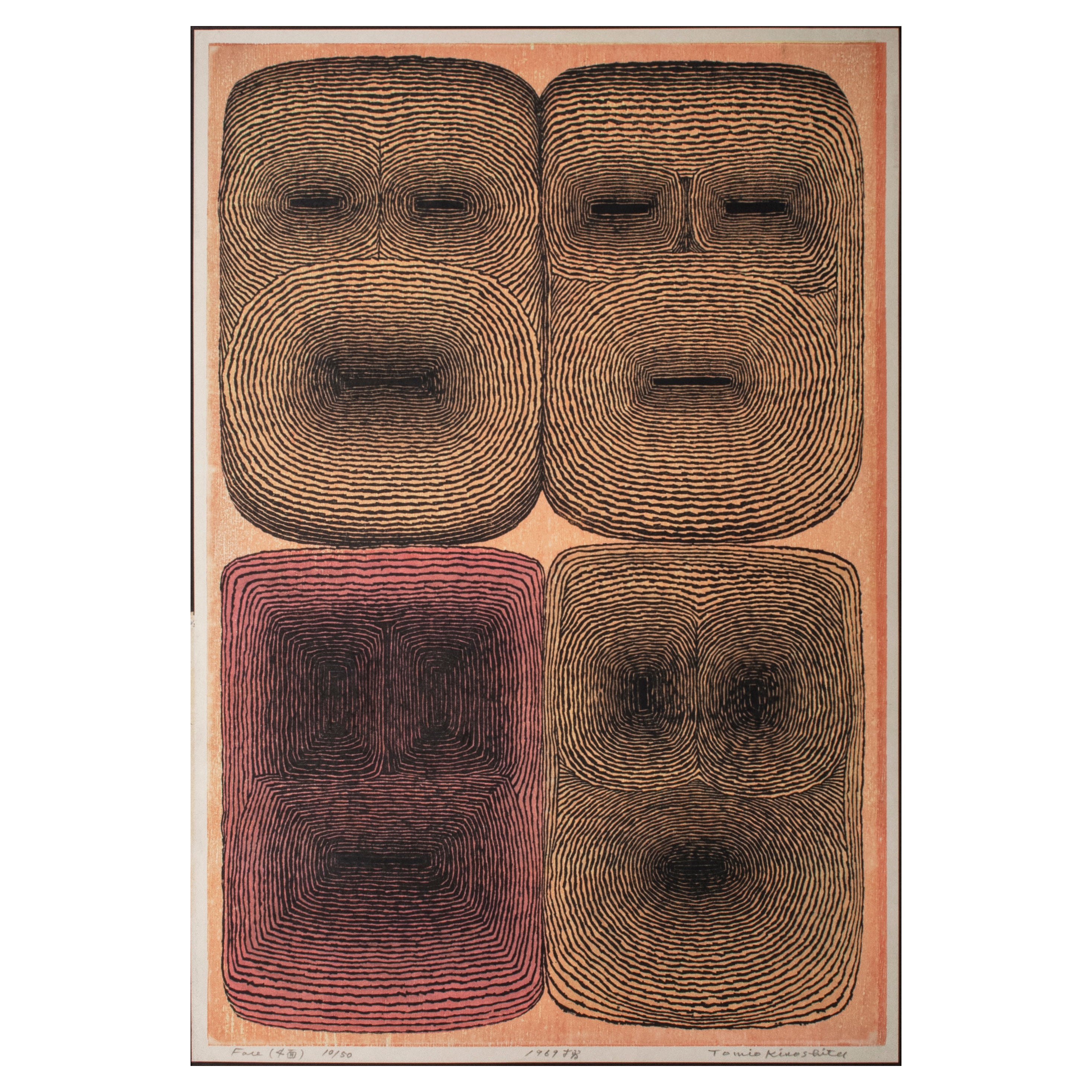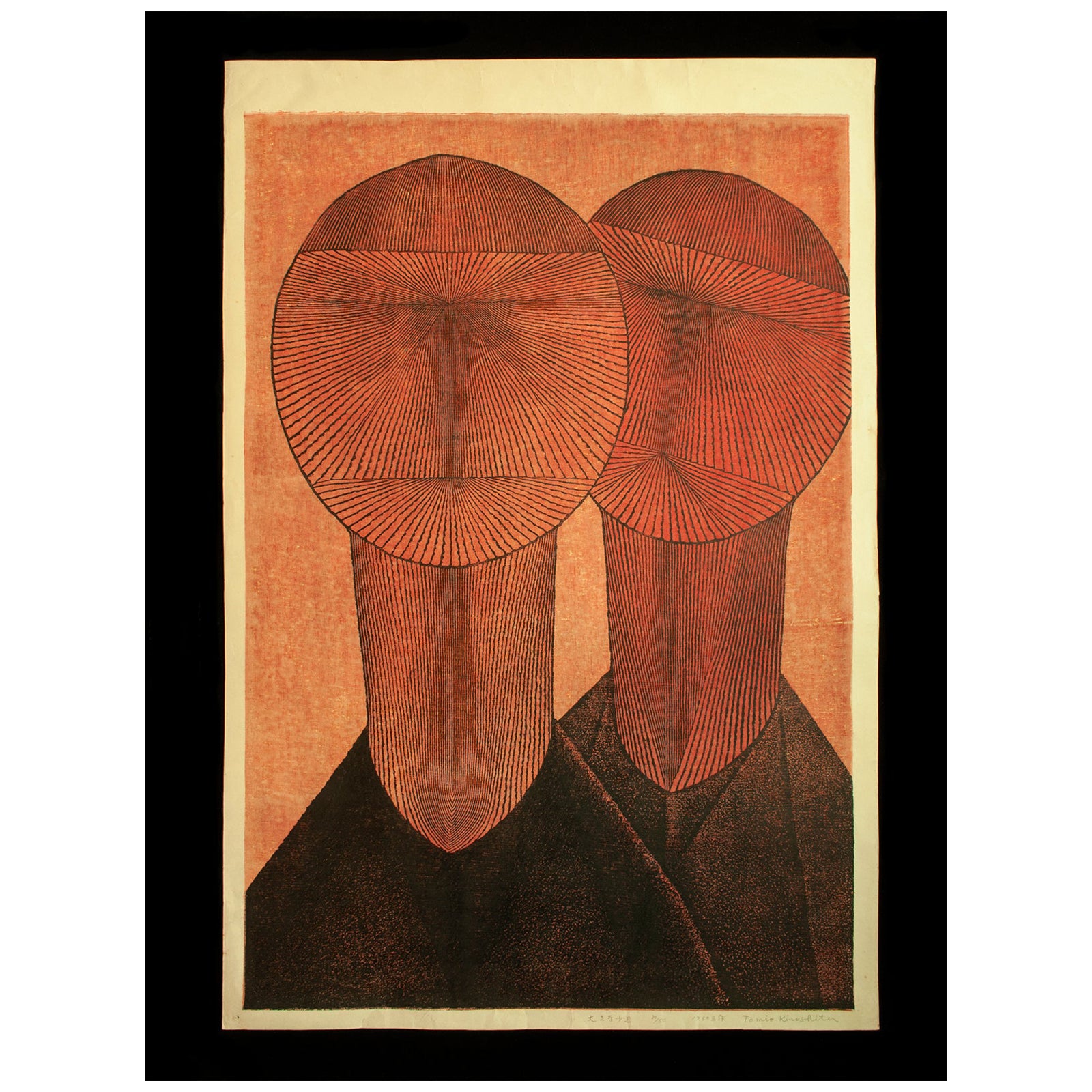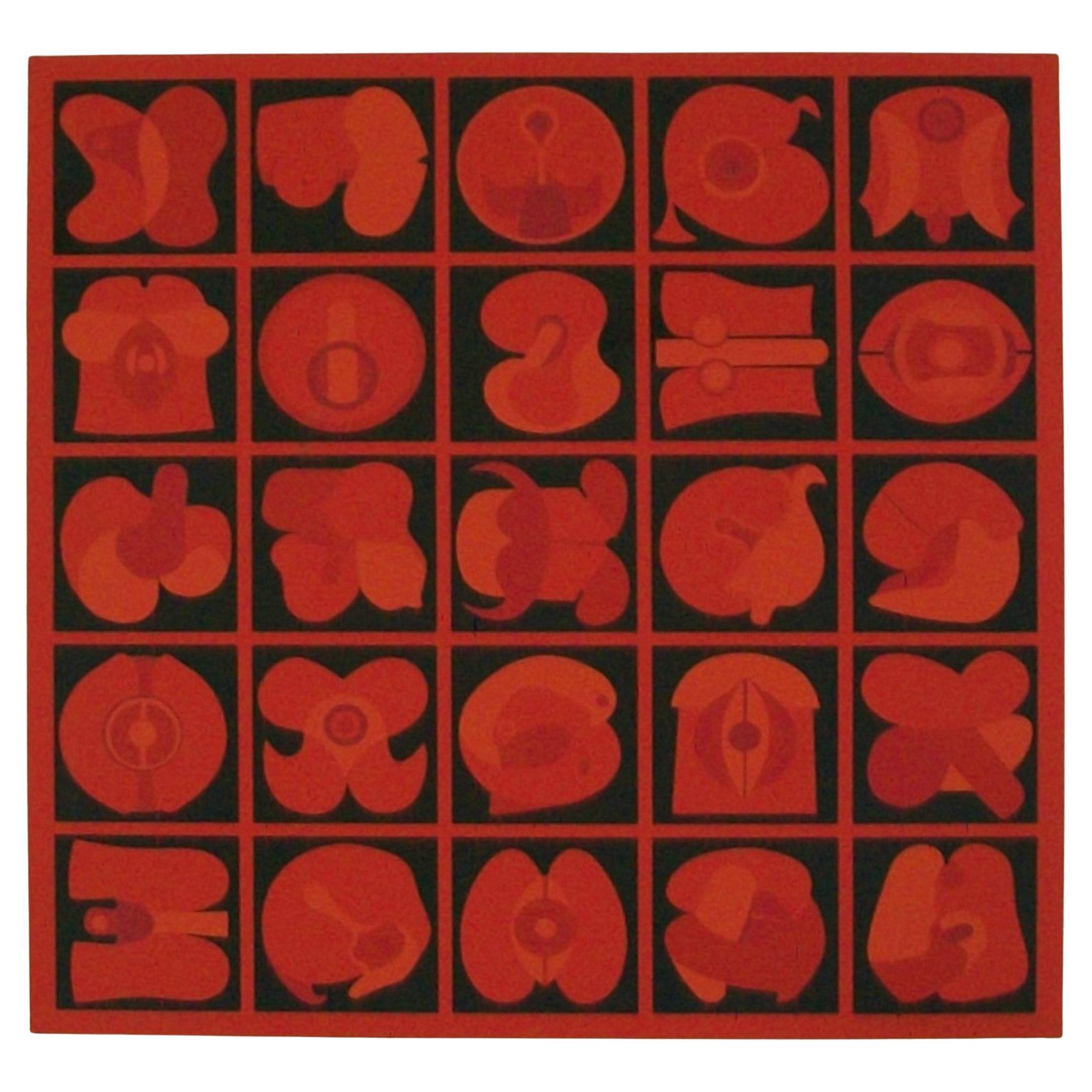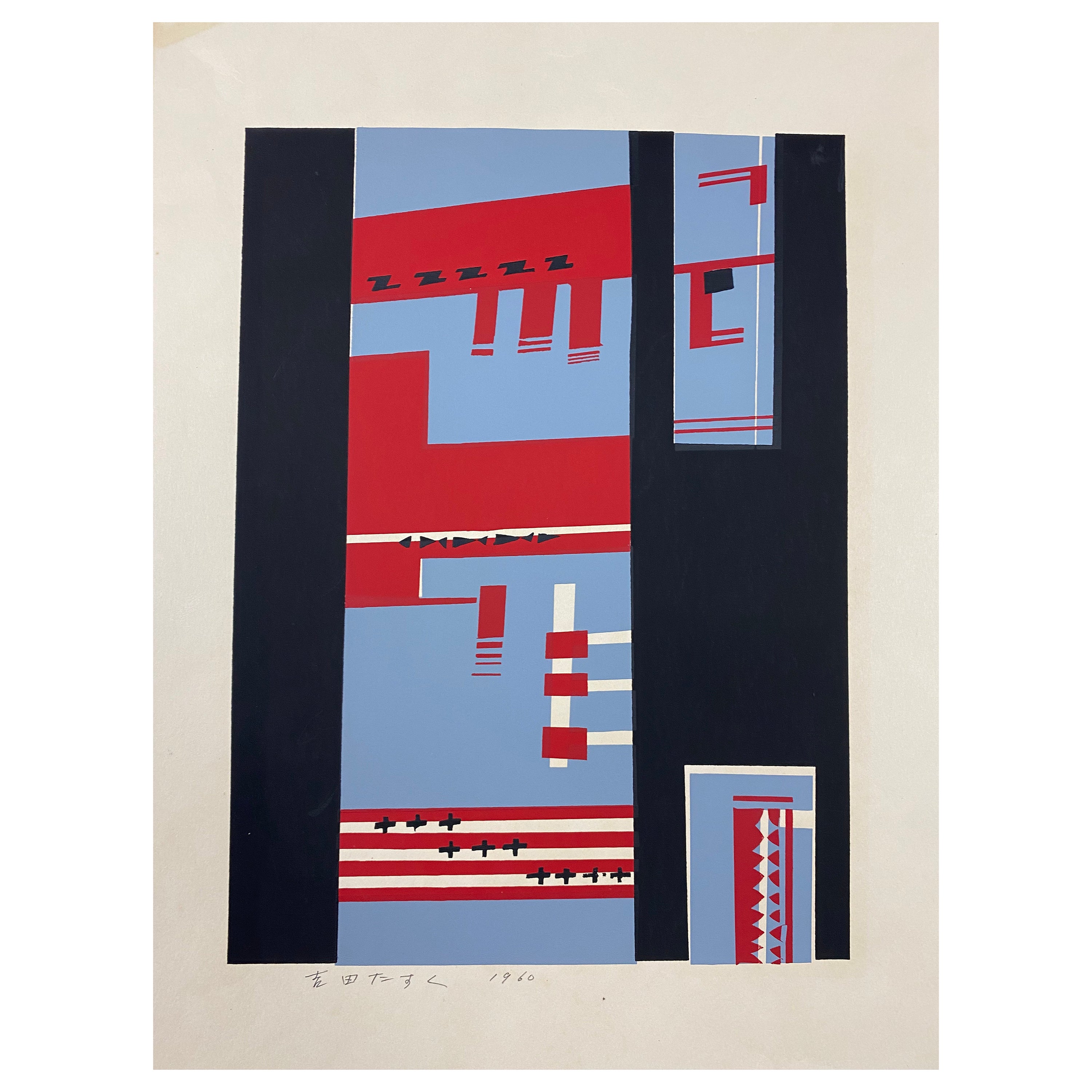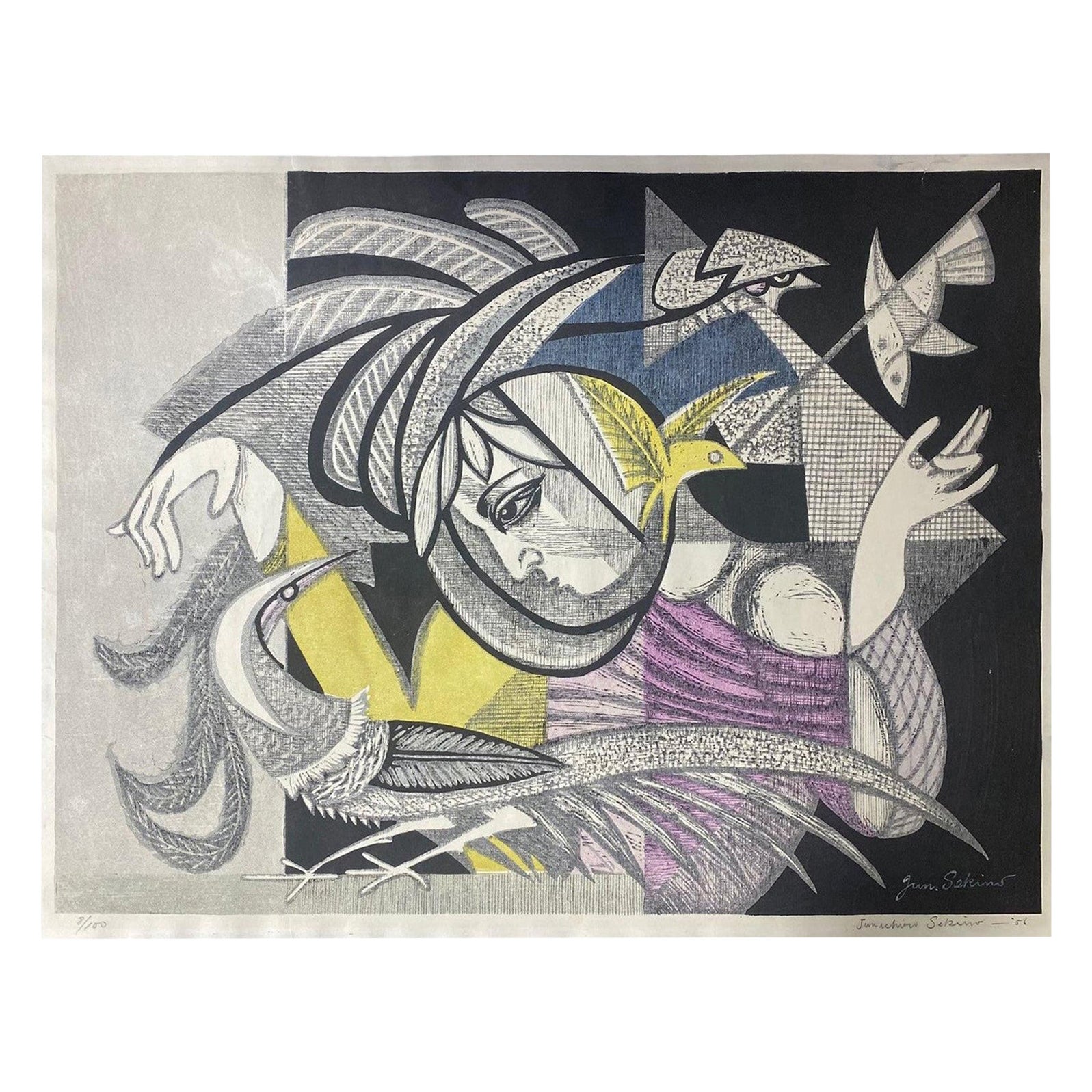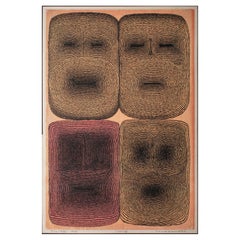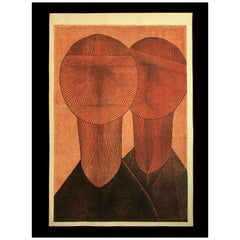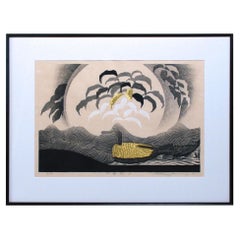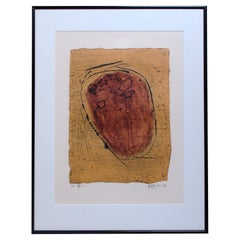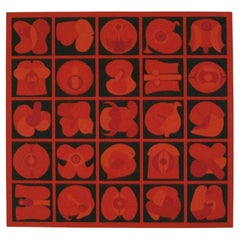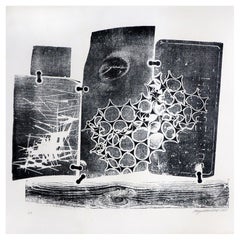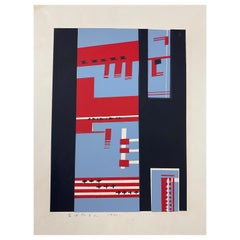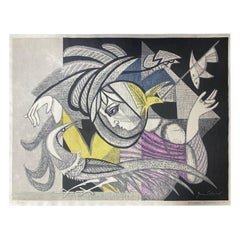Items Similar to 1981 Graphic Woodblock Print by Tomio Kinoshita, Japan
Want more images or videos?
Request additional images or videos from the seller
1 of 6
1981 Graphic Woodblock Print by Tomio Kinoshita, Japan
$6,000
£4,555.94
€5,210.06
CA$8,382.87
A$9,323.58
CHF 4,868.48
MX$113,458.07
NOK 62,177.98
SEK 58,311.97
DKK 38,884.67
Shipping
Retrieving quote...The 1stDibs Promise:
Authenticity Guarantee,
Money-Back Guarantee,
24-Hour Cancellation
About the Item
Tomio Kinoshita (1923 - 2014)
Masks (No. 4), 1981
Woodblock print
Image Size: 22 high by 31 inches wide (56 by 79 cm)
Paper Size: 22.75 high by 31.5 inches wide (57.8 by 80 cm)
Signed: in pencil lower right, Tomio Kinoshita
Titled: in pencil at lower left
Edition: 30/50
Condition: Excellent.
The woodblock for this powerful print was carved in 1957, very early in Kinoshita's career. As with many sosaku hanga artists, Kinoshita pulled prints as they were needed, so this one is from 1981, numbered 30/50.
This iconic image can be found in the permanent collections at LACMA, the Cincinnati Art Museum, Minneapolis Institute of Art, Honolulu Art Museum and the fine Arts Museum San Francisco.
It was included in an exhibition titled "Taming the Elements: Contemporary Japanese Prints and Ceramics" in 2014 at the Cincinnati Art Museum. It was also illustrated in "Japanese Prints: From the Early Masters to the Modern" by James A. Michener, 1959, p. 242, pl. 248 and in the Mie Prefectural Art Museum exhibition catalog, "Tomio Kinoshita", plate 9.
A copy of the catalog will be included with purchase.
- Creator:Tomio Kinoshita (Artist)
- Dimensions:Height: 22.75 in (57.79 cm)Width: 31.5 in (80.01 cm)Depth: 0.07 in (1.78 mm)
- Style:Mid-Century Modern (Of the Period)
- Materials and Techniques:Paper,Other
- Place of Origin:
- Period:1980-1989
- Date of Manufacture:1981
- Condition:Minor losses.
- Seller Location:Point Richmond, CA
- Reference Number:Seller: ZK#26031stDibs: LU1778233718232
About the Seller
5.0
Platinum Seller
Premium sellers with a 4.7+ rating and 24-hour response times
Established in 1999
1stDibs seller since 2015
686 sales on 1stDibs
Typical response time: 2 hours
- ShippingRetrieving quote...Shipping from: Point Richmond, CA
- Return Policy
Authenticity Guarantee
In the unlikely event there’s an issue with an item’s authenticity, contact us within 1 year for a full refund. DetailsMoney-Back Guarantee
If your item is not as described, is damaged in transit, or does not arrive, contact us within 7 days for a full refund. Details24-Hour Cancellation
You have a 24-hour grace period in which to reconsider your purchase, with no questions asked.Vetted Professional Sellers
Our world-class sellers must adhere to strict standards for service and quality, maintaining the integrity of our listings.Price-Match Guarantee
If you find that a seller listed the same item for a lower price elsewhere, we’ll match it.Trusted Global Delivery
Our best-in-class carrier network provides specialized shipping options worldwide, including custom delivery.More From This Seller
View All1969 Graphic Woodblock Print by Tomio Kinoshita, Japan
By Tomio Kinoshita
Located in Point Richmond, CA
Faces (4 Faces), 1969
Tomio Kinoshita (1923-2014), Japan
Woodblock print
Paper, pigment, sumi ink
Image: 27 high by 18.25 inches wide (68.5 by 46.4 cm)
Paper size: 28 high by 19...
Category
Vintage 1960s Japanese Mid-Century Modern Prints
Materials
Paper
1960 Big Boys, Woodblock Print by Tomio Kinoshita, Japan
By Tomio Kinoshita
Located in Point Richmond, CA
Tomio Kinoshita (1923 – 2014)
Big Boys, 1960
Woodblock print
Image size: 32.75 high by 22 inches wide (83 by 56 cm)
Paper size: 35.5 high by 23.75 inches wide (90 by 60.3 cm)
Signed: in pencil lower right, Tomio Kinoshita
Titled: in pencil at lower left
Edition: 30/50
Condition: Very good
The woodblock for this large print was carved in 1958, just three years after Kinoshita’s began creating woodblocks. This print was signed and dated in 1960, but not numbered; prints were also pulled from this block in the 1970s, so it must have been one of more popular images.
One of his students has written, “As time progressed further, the postwar era saw improvements in nutrition, and children became taller and heavier than in the past, but their lack of physical exercise and severely inferior physical abilities became a social problem; this is ironically depicted in Big Boys.” In 1963, Kinoshita told him that he had just finished pulling a print of this image in response to a request from Unichi Hiratsuka...
Category
Vintage 1960s Japanese Mid-Century Modern Prints
Materials
Paper
Reika Iwami, Contemporary Japanese woodblock print
By Reika Iwami
Located in Point Richmond, CA
Contemporary Japanese woodblock print (Sosaku hanga) by the female artist Reika Iwami (b. 1927, Tokyo) titled “Water Fantasy A”of a setting full moon on th...
Category
Vintage 1980s Japanese International Style Prints
Materials
Paper
Japanese Collagraph Print by Tsuguo Yanai, "Broken Heart"
By Tsuguo Yanai
Located in Point Richmond, CA
Japanese Collagraph Print by Tsuguo Yanai (b. 1953, Hagi, Yamaguchi), titled “Broken Heart” in Japanese with the printing number 2/30 under the image on the left and pencil signatur...
Category
Vintage 1980s Japanese International Style Prints
Materials
Paper
Chinese ink and watercolors on paper, Luis Chan (Chen Fushan)
By Luis Chan (Chen Fushan)
Located in Point Richmond, CA
Chinese ink and water colours painted on paper by the artist, Luis Chan (Chen Fushan) 1905-1995, a fantasy landscape depicting islands in a dream blue sea, o...
Category
Vintage 1970s Hong Kong Post-Modern Paintings and Screens
Materials
Paper
Antique Japanese Stencil-Dyed Han-Juban
Located in Point Richmond, CA
Antique Japanese Stencil-Dyed Han-Juban
Han-juban are worn under kimono. This example, without its original cotton sleeves, displays a unique stencil-dyed pattern with indigo. A ve...
Category
Early 20th Century Japanese Taisho Tribal Art
Materials
Cotton
You May Also Like
TAKESHI KAWASHIMA - No. 68 - Mid Century Original Lithograph - Circa 1960's
By Takeshi Kawashima
Located in Chatham, ON
TAKESHI KAWASHIMA (Japanese/American b. 1930) - Untitled No. 68 - 75/80 - Mid Century original lithograph on paper - featuring a gridded pattern with semi abstract shapes - unframed ...
Category
Mid-20th Century American Mid-Century Modern Prints
Materials
Paint, Paper
Limited Edition Untitled Woodblock Print by Margaret Wenstrup '1958'
Located in Brooklyn, NY
An untitled abstract woodblock print by Margaret Wenstrup (1930-2008) dated 1958. Wenstrup was a well-known Cincinnati, OH artist who graduated from ...
Category
Mid-20th Century Mid-Century Modern Prints
Materials
Paper
Japanese Mid-Century Modern Woodblock Print by Tasuku Yoshida
Located in Weesp, NL
1960's Japanese woodblock print untitled by Japanese asian and modern & contemporary artist Tasuku Yoshida.
The At work is signed and dated in pencil by the artist. The Art work is ...
Category
Vintage 1960s Japanese Mid-Century Modern Prints
Materials
Paper
Junichiro Sekino Signed Limited Edition Abstract Japanese Woodblock Print, 1956
By Junichiro Sekino
Located in Studio City, CA
A truly wonderful and exceedingly rare abstract limited edition woodblock print by famed Japanese artist/printmaker Junichiro Sekino.
This print, which appears to be titled "Tori & ...
Category
Vintage 1950s Japanese Showa Prints
Materials
Paper
Kiyoshi Saito Signed Limited Edition Japanese Woodblock Print Tosyodai-Ji Nara
By Kiyoshi Saitō
Located in Studio City, CA
A beautifully composed, rare woodblock print by famed Japanese printmaker Kiyoshi Saito. Many consider Saito to be one of the most important, if not the most important, contemporary Japanese printmakers of the 20th century. This print is titled "Tosyodai-Ji Nara". The wood grain and rich colors are amazing.
The print is signed in white ink and stamped within the image and titled, dated (1959) and numbered (75/80) in pencil by the artist in the lower margin. This particular image is quite rare and hard to find. A copy of this print can be found in the Museum of fine Arts in Boston.
Would be a great addition to any modern Japanese print...
Category
Vintage 1950s Japanese Showa Prints
Materials
Plexiglass, Paper
Kenji Yoshida "Oribe" Woodblock Print, 3/30 Signed, 1968
By Kenji Yoshida
Located in Miami, FL
Kenji Yoshida "Oribe" woodblock print, 3/30 Signed, 1968
Offered for sale is an early woodblock print by artist Kenji Yoshida (1924-2009), signed and dated 1968 and numbered 3/30 ...
Category
Mid-20th Century French Prints
Materials
Wire
More Ways To Browse
Graphic Furniture
Mid Century Japan Mask
Okinawa Furniture
Japanese Woodblock Book
Japanese Woodblock Print Blue
Wood Block Print
Asian Diptych
The Eye By Kiyoshi Saito
Japanese Woodblock Triptych
Japanese Woodblock Couple
Saito Wood Print
Kyoto Saito
Tanaka Ryohei
Colonial Antique Singapore
Yanagawa Shigenobu
Woodblock Print Clouds
Ginseng Antique
Karhu Woodblock Prints
